Lecture given on October 15, 2009 at a public forum with Zoya of RAWA, "Afghanistan: Resisting Occupation and Fundamentalism," organized by United for Justice with Peace and the Afghan Women's Mission, held at Harvard Law School, Cambridge, Massachusetts
The casing of a CBU-87 cluster bomb found in Tora Bora had a hand-stenciled note on it, "this is gonna shine like a diamond in a goat's ass - Gary."[1]
Air bombardment is the terrorism of the rich - C. Douglas Lummis[2]
Ten Main Points:
1. The execution of America's post-Korean wars in the Third World is all about the differential value of life put on those colored "Others," in other words, race/ethnicity matters. This can be seen in the language/framing of official discourse, in the language of soldiers, and in outcomes exposing the differential value of life practiced by Americans such as in compensation for wrongful death;
2. America's war in Afghanistan has been anything but a "precision" war executed with new, high-tech weapons. The fault lies less in the weapons themselves and more in how they have been used by American military personnel carrying out the policies of the Bush and Obama administrations. The metric of civilians killed to occupation soldiers killed, measures the relative lethality of the American-led Afghan war. I demonstrated that Taliban suicide-bombers are more precise than U.S. high-tech aerial bombs;
3. The costs of this war for Afghanistan and the Afghan people are enormous and multi-dimensional;
4. The "new" war approach by General McChrystal which has substituted rising deaths of (mostly lower class rural) American soldiers for lesser Afghan civilian deaths (in order to maintain a NATO effort) confirms what I have long been arguing: U./S aerial strikes were a chosen way of minimizing U.S casualties at the expense of Afghan civilian deaths and injured;
5. Obama, the quintessential Mr. Image, has significantly escalated the U.S-led war in Afghanistan and Pakistan, whereas the older NATO allies are increasingly reluctant to continue what augers to be a war without end. They are intelligently avoiding the sunk cost fallacy whereas Obama is embracing it. On the other hand, the U.S. cannot pursue this war on its own (along with some token , ill-trained Estonians, Mongolians, Colombians, or Macedonians);
6. The U.S mainstream media, especially television (e.g., CBS News' Lara Logan) and talk radio but also the Associated Press wire service, has played a major role in confusing the American general public about the reasons for and the execution of America's Afghan war. Where are all the photos of those obliterated and/or maimed by U.S troops?[3]
7. Other American commentators - the humanitarian interventionists on Afghanistan - including Human Rights Watch, National Public Radio, Sarah Chayes, Harvard's Carr Center, etc. - present a completely idyllic end-game where jolly Afghan farmers labor in cooperatives producing pomegranates or saffron for export and Afghan girls' schools dot the countryside. This has nothing to do with reality and all with marketing/selling the war to the American general public;
8. America's Afghan war is unwinnable militarily as well as in a hearts-and-minds counter-insurgency terms. Moreover, the American bombing and subsequent occupation of Afghanistan has strengthened, not weakened, Al Qaeda by promoting its decentralization across at least two continents (Asia and Africa). Thanks to America, Al Qaeda is now a global organization;
9. The only solution is for the U.S to withdraw as expeditiously as possible just as the Soviets did in 1989, letting Afghans work out a livable arrangement as the Vietnamese did in 1975. The Obama/McChrystal approach promises war without end and the Biden approach is an invitation for a second 9/11;
10. History tells us very clearly that the single most important factor which motivates a U.S withdrawal from a conflict soon is escalating U.S. military casualties. The lessons from Indochina (1965-75), the Lebanon bomb attack which killed 241 US troops (1983), Somalia's Blackhawks down (1993) are clear for all to see.
I wish to focus in my talk upon the execution of (not the rationales for) war and on the effects of this U.S-led war upon Afghanistan and its people. A fully referenced version of my talk is coming up on RAWA's web site as I speak.
Let me begin with a brief comment. As all marketing accepts, words matter and we thus need to struggle which meaning dominates. Let me give you two examples: the U.S/NATO presence in Afghanistan is not about peace-keeping but rather about a foreign occupation; and those fighting such occupation are neither terrorists nor insurgents but rather the resistance (though maybe not our preferred type of resistance). A strange thing happened during the last twenty years: any force opposing U.S. geo-political designs around the world is now labeled terrorist. As Mike Davis so tellingly pointed out, the car bomb or suicide-bomber is the air force of the poor.[4] The Axis armies of mid-twentieth century were never labeled terrorist. You see this war is as much about words, meanings, images and information as it is about IED's and GPS-guided bombs.
I begin with an uncomfortable fact: race/ethnicity matters in the execution of America's post-Korean wars in the Third World (whether in Indochina, El Salvador, Iraq, Somalia, or Afghanistan). We see this in the differential value put on the lives of those "Others", as well as in the language/framing of official discourse and in the language of common U.S. soldiers (graffiti, inscriptions on bombs and missiles destined to rain down upon Afghanistan or Iraq like "Here's a Ramadan present from Chad Rickenberg", [5] in e-mails [mentioning "Afghan ragheads"], at Abu Ghraib, use of the term 'Islamo-fascists', etc.). [6] U.S. official and media demonization of "the enemy" - a long U.S. tradition [7] - gets translated into such inscriptions on bombs and the like. In 1989, Christopher Hitchens published excerpts from a songbook produced and distributed by the US Air Force's 77th Tactical Fighter Squadron (based in South Carolina): "Phantom flyers in the sky, Persian-pukes prepare to die, Rolling in with snake and nape [8], Allah creates but we cremate."[9]
Slide #1. Here and There
In America: inscribing a 2,000 pound bomb ("what goes around, comes around") [U.S DoD photo]
In Afghanistan, the result of a 2,000 lb bomb dropped on a home in Kapisa on March 5, 2007, which killed 9 civilians in one family - including members of 4 generations [Associated Press photo]
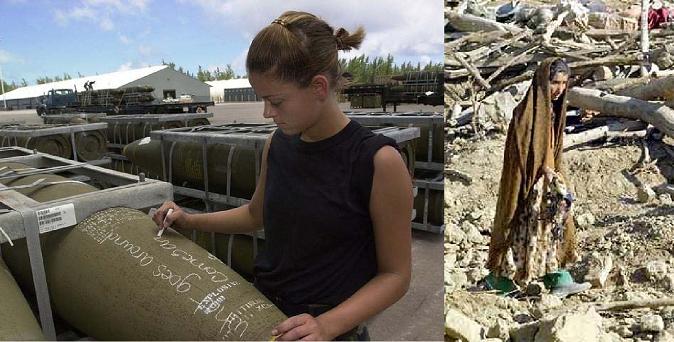
The Afghan academic Mir Hekmatullah Sadat wrote,
Let's face it: Osama Bin Laden, Al-Qaeda, and their supporters do not represent the 20 million people of Afghanistan. Misrepresentation of facts to the masses, naive assessments, and faulty research by the media and scholars have incited the world against Afghans by dehumanizing them. This is what Edward Said calls "Orientalism." Demonizing Afghan culture by giving the impression that Afghans are savages while Americans are this "bourgeois" or civilized culture is immoral. This type of splitting up the world between civilized and un-civilized will not end the terrorism directed at Americans and Afghans. This rhetoric is based on race models rooted in Euro-centric ideologies of the 19th century. It is a slap in the face of those working for peace and unity in Afghanistan and America. Furthermore, it casts doubt onto the academic scholars who publish such travesties. [10]
Slide #2. Insert cover page of Frontline (October 24, 2008)
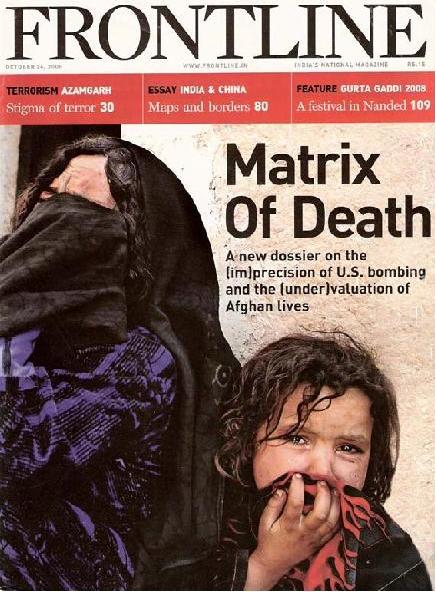
Let's take the matter of U.S. drone strikes so cherished by President Obama and Vice-President Biden. As the independent Representative Ron Paul noted,
What if tomorrow morning you woke up to headlines that yet another Chinese drone bombing on U.S. soil killed several dozen ranchers in a rural community while they were sleeping? That a drone aircraft had come across the Canadian border in the middle of the night and carried out the latest of many attacks? What if it was claimed that many of the victims harbored anti-Chinese sentiments, but most of the dead were innocent women and children? And what if the Chinese administration, in an effort to improve its public image in the U.S., had approved an aid package to send funds to help with American roads and schools and promote Chinese values here? Most Americans would not stand for it. Yet the above hypothetical events are similar to what our government is doing in Pakistan. Last week, Congress did approve an aid package for Pakistan for the stated purposes of improving our image and promoting democracy. ..What if this happened on U.S. soil? What if innocent Americans were being killed in repeated drone attacks carried out by some foreign force who was trying to fix our problems for us? Would sending money help their image? [11]
For those more inclined to numerical evidence, I have been documenting now for six years how the differential value put upon life (and death) is revealed in the compensation paid for wrongful deaths by the U.S. military. When we make the comparisons in purchasing power parity terms, we find the following very clear gradient in the valuation of life possessing a strong color gradient:
Slide #3: Table 1. The Monetary Value of Life Paid in Compensation Measured in PPP $'s
| Victim’s nationality | in nominal $'s | GDP PPP$'s/GDP | in PPP US $'s |
| US $'s ratio | |||
| of Americans 1988* | $1'850'000 | 1.00 | $1'850'000 |
| of WTC victims 2002 | $ 1'800'000 | 1.00 | $ 1'800'000 |
| of Italians 1998 | $1'900'000 | 1.09 | $ 2'071'000 |
| of Japanese 2001 | $1'440'000 | 0.70 | $1'010'000 |
| of Chinese 1999 | $ 150'000 | 4.58 | $ 687'000 |
| of South Koreans 2002 | $162'500 | 1.7 | $276'250 |
| of Iranians 1998 | $ 132'000'000/290 | 2.5-3 | $ 125,172 |
| of Indians (Bhopal) 1984 | $3'200 | 5.01 | $16'032 |
| of Afghans @ lifetime | $ 3'300 - $ 5'000 | ~4** | $13,200-$20,000 |
| earnings*** | |||
| of Afghans @ US military | $2000 | ~4 | $8'000 |
| of Afghans @ Diyat | $25,000 | ~ 4 | $100,000 |
Source: Herold, Matrix, op. cit.
*average compensation paid to 270 victims of the 1988 Lockerbie, Scotland, Pan Am Flight 103 disaster [see Amanda Ripley, "WTC Victims: What's A Life Worth," Time (February 6, 2002)). The value for victims of airplane crashes into World Trade Center is from Beverly Eckert, "My Silence Cannot Be Bought," USA Today (December 19, 2003). In 1984, in United States court cases, awards for a person negligently killed were $500'000. Recent estimates used by the Environmental Protection Agency have been $ 6.1 million [see the excellent paper by Frank Ackerman and Lisa Heinzerling, "The $ 6.1 Million Question" [Medford, MA.: Global Development and Environment Institute Working Paper No. 01-06, Tufts University, April 2002], available at: http://ase.tufts.edu/gdae). A comprehensive bibliography on the Economics of Disasters and Valuation of Life may be found at www.geo.umass.edu/courses/geo510/economics.htm.The figure for Bhopal is from http://www.iced.org.au/files/iced/bhopal/injustice.html
**the Afghan ratio of 4 is estimated on basis of GDP data and it is close to that for Pakistan where prices are similar, a ratio of 4.25 in Pakistan. The Afghan and Pakistani economies have been very tightly linked monetarily.
***an average Afghan earns about $300 a year and life expectancy is in the low 40's.
Were an Afghan compensated for according to the traditional Afghan practice of the Diyat, the amount would approach that paid out (in PPP $'s) by the United States to the family of a victim of the Iranian Airbus shooting-down in 1998. Instead, the U.S, military distributes a condolence payment one-fifteenth the amount offered to the family of an Iranian victim.
Lew Rockwell noted that Americans believe they are the chosen people (expressed in more academic terms as an alleged "American exceptionalism" meaning a belief that the U.S. has a special world historical role to play [12]). Others have argued that the USA suffers from a pathological narcissistic personality disorder. [13] Hence, an American life is higher on the scale of human civilization than say that of an Afghan, Indian or Iraqi. In order to preserve lives of American soldiers a trade-off is implemented: the U.S, military simply relies upon air strikes instead of ground forces as the former entails essentially no risk whereas ground combat in difficult, foreign terrain like Afghanistan is treacherous. In other words, certain Afghan civilian casualties are traded-off for sparing the lives of U.S. ground soldiers. America's Afghan war has been particularly deadly for innocent civilians.
In the United States, three levels which interact are at play to put a low value on Afghan lives:
Slide #4
Whereas bombs and missiles are now more precisely targeted using laser or GPS guidance systems, the very high explosive power of the bombs guarantees that civilians in the general area of the impact bomb will be killed. When U.S. military personnel drop such bombs in civilian-rich areas, innocents die. The numbers of civilians killed per 10,000 tons bombs delivered was: 4,744 in the Allied bombing campaign of Germany during World War II; 870 in the U.S. bombing of North Vietnam during Rolling Thunder; 1,840 during the intense U.S. bombing of Cambodia; and over 2,000 during the three months' U.S. bombing of Afghanistan in 2001. [14]
Slide # 5: Table 2. Civilians Killed per 100 Metric Tons of Bombs Dropped
| Total | Number of Civilians | Ratio of civilians | |||||
|
| tonnage | killed | killed | per | 100 | ||
|
| dropped | | tons | | | ||
| | | 1,250,000 | 593,000 | 47.4 | | | |
| | 600,000 | 52,000 | 8.7 | | | ||
| 1964-67 | | | | | | | |
| North | | II, | 15,287 | 1,318 | 8.6 | | |
| 1972 | | | | | | | |
| | | 2,400,000 | 350-500,00 | 14.6-20.8 | | ||
| | | 2,756,941 | 275-826,000 | 11.5-34.4 | | ||
| | | 60,624 | 2,278 | 3.8 | | | |
| | | 13,000 | 1,200 | 9.2 | | | |
| | 14,000* | 2,569-2,949 | 18.4-21.1 | | |||
| 10, 2001 | | | | | | | |
| | | 6,350 | 940-1,112 | 14.8-17.5 | | ||
| U.S Afghanistan 2006 |
| 261 | 653-769 | 250-295 | | | |
| at 50% |
|
| 261 | 326-385 | 125-148 | | |
| U.S. Afghanistan 2007 |
| 567 | 1,010-1,297 | 178-229 | | | |
| at 67% |
| 567 | 678-869 | 119-153 | | | |
| U.S. Afghanistan 2008, ½ year |
| 630 | 273-335 | 43-53 | | | |
| at 67% |
| 630 | 183-224 | 29-36 | | | |
Source: Herold, Matrix, op. cit. Laos's data from http://www.zmag.org/znet/viewArticle/17848; Yugoslavia and Rolling Thunder data from Kaplan (1999); Cambodia data from Ben Kiernan; Iraq Gulf War casualties reported by Iraqi civil defense authorities.
*figure is for October 2001 - February 2002
The relative lethality of the U.S-led war in Afghanistan is captured by the ratio of civilians killed to U.S/NATO occupation soldiers killed. The following Table 3 summarizes such data. Over three Afghan civilians died for every occupation soldier killed during 2005-middle of 2009; in other words, the execution of the U.S-led war was more than three times more deadly for innocent Afghans than it was for the aggressor forces. Naturally, the costs of the American-led war far exceed that of civilians killed by US/NATO forces, but time does not allow exploring such here. [15]
Slide #6: Table 3. The Relative Lethality of the U.S/NATO War in Afghanistan
| | (1) Afghan and | (2) U.S/NATO soldiers | Civilians killed per | |
| | Pashtun civilians | | killed | Occupation Soldier |
| | killed in U.S/NATO | | | Death |
| | actions | | | |
| Oct-Dec 2001 | 2569-2949 (midpoint | 12 @ US | 189.7 | |
| | @ 2759) | | | |
| 2005 | 408-478 (midpoint @ | 131 (99 @ US) | 3.4 | |
| | 443) | | | |
| 2006 | 653-769 (midpoint of | 191 ( 98 @ US) | 3.7 | |
| | 711) | | | |
| 2007 | 1010-1297 (midpoint | 232 | (117 @ US) | 5.0 |
| | of 1154) | | | |
| 2008 | 864-1017 (midpoint | 294 | (155 @ US) | 3.2 |
| | of 941) | | | |
| Jan-June 2009 | 520-630; 575 midpt | | 156 | 3.7 |
| July 2009 | 47-56; 52 midpt | 71 | (45 @ US) | 0.7 |
| August 2009 | 64-66; 65 midpt | 70 | (51 @ US) | 0.9 |
| October 1-10, 2009 | 15 | | 28 | 0.5 |
The Table 3 above documents my fourth point: the reduction of U.S aerial strikes ordered by General McChrystal has led to a precipitous drop in the ratio of civilians killed per occupation soldier - from 3.7 for the first half of 2009 to about 0.8 during July-August 2009. In effect, in order to maintain a fracturing NATO coalition in Afghanistan, McChrystal was forced to field more U.S ground forces and absorb far higher levels of occupation soldier casualties. This point is enormously important as it confirms what I have long been arguing: U.S aerial strikes were a chosen way of minimizing U.S casualties at the expense of Afghan civilian deaths and injured. In other words, a conscious self-serving U.S decision was made to impose undue harm upon Afghan civilians. That is a war crime. Moreover, as I have long argued and documented, some 60-70 percent of Afghan civilians killed by U.S and NATO forces have been women and children [16]. That is another war crime!
My fifth point deserves little elaboration. Obama has ratcheted up the American-led war upon Afghanistan, proclaiming it to be a "war of necessity." Evidence for escalation includes a major surge in U.S occupation forces and extending the war into the Pakistan border regions with U.S drone strikes. U.S occupation forces numbered 52,000 uniformed personnel and 68,000 contractors in Afghanistan in March 2009 according to the Congressional Budget Office, to which now needs be added Obama's extra 14,000 and McChrystal's additional requests of 40-60,000, making 174-194,000 (far exceeding the Soviet's' 115,000 peak). The drone strikes are contributing to the further destabilization of Pakistan and the rapid growth of the forces of radical Islam. The equation is simple: drone strikes which kill recruit future suicide bombers, merely serving to promote a future of war without end. The weak link in Obama's escalation is Old Europe and Canada. These governments are increasingly wary of such war without end, all the more so as the aim of this war remains ill-defined. These countries' leaders unlike Obama are no embracing the sunk-cost fallacy (escalating in "order to get the job done"). The Al Qaeda attacks in London, Madrid, etc. need not be planned in the Afghan-Pakistan area, but can be concocted in Florida, Hamburg, Yemen, etc. If Old Europe withdraws its occupation forces, the U.S. will not be able to continue its large-scale ground war - token numbers of ill-trained Estonians, Mongolians and Macedonians will not do.
Most of the above remains insufficiently mediagenic to be reported in the United States. In 2008, John Pilger of Britain wrote about Obama is the prince of bait-and-switch,
Those who write of Obama that "when it comes to international affairs, he will be a huge improvement on Bush" demonstrate the same willful naivety that backed the bait-and-switch of Bill Clinton - and Tony Blair…Eleven years and five wars later, at least a million people lie dead. Barack Obama is the American Blair. That he is a smooth operator and a black man is irrelevant. He is of an enduring, rampant system whose drum majors and cheer squads never see, or want to see, the consequences of 500lb bombs dropped unerringly on mud, stone and straw houses…(Bush press spokesman) Scott McClellan has called "complicit enablers" - journalists who serve as little more than official amplifiers. Having declared Afghanistan a "good war", the complicit enablers are now anointing Barack Obama as he tours the bloodfests in Afghanistan and Iraq. What they never say is that Obama is a bomber. [17]
The U.S corporate media has spent eight long years serving as the Pentagon's mouthpiece - naturally some news reporters buck the trend maintaining independence, e.g., Carlotta Gall (New York Times) and Kathy Gannon come to mind. I have documented this in numerous publications. [18] During 2001-5, this media was enthralled with the notion of "precision weaponry," assuring the U.S public that the U.S was waging a clean, antiseptic war. Once the Taliban & Co. resistance began going on the offensive and war-related deaths soared, the media simply chose to omit reporting upon Afghan civilian casualties; the only exception being cases where the death toll was huge and simply could not be hidden, e.g., a fine example of that was the recent slaughter of close to 100 Afghan civilians executed by two USAF F-15E Strike Eagles. [19] Special effort was devoted to not printing any photos of innocent Afghans killed or wounded by U.S bombs or ground forces. [20] Photos like the following never appear in the U.S corporate media or in Human Rights Watch (and publications of the other humanitarian interventionists):
Slides #'s 7, 8, 9, 10 and 11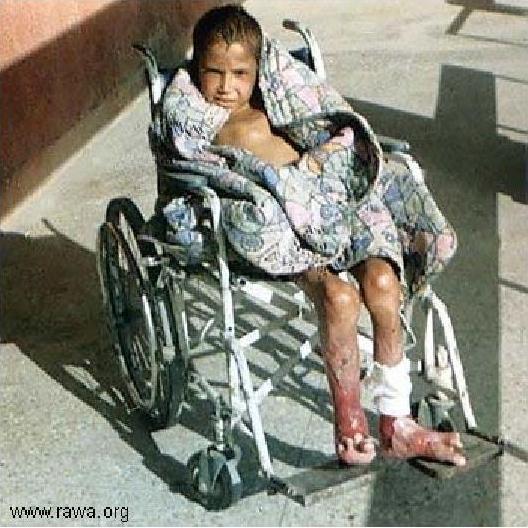
Mohammad Khan, 9 years old, son of Sher Afghan was wounded on Nov.11, 2001 when a U.S B-52 war plane dropped a bomb on Korang village of Surkhrod district in Nangrahar province, south of Afghanistan. He is suffering since past 3 years and due to poor health care facilities he never recovered from the painful wounds. The photo was taken on Dec.12, 2004 when he was visiting a hospital in Jalalabad city.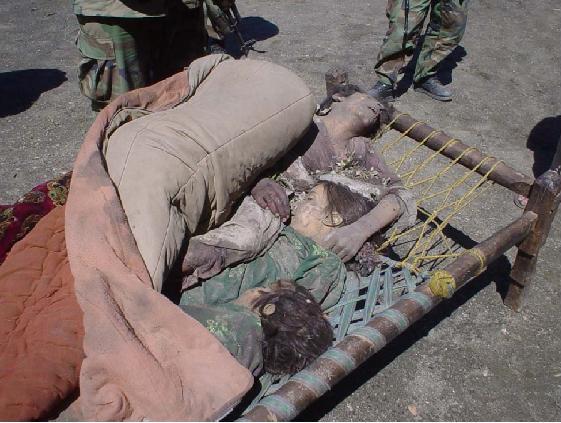
Victims of a U.S aerial bombing attack in the hamlet of Landigal in the Korengal Valley, April 15, 2006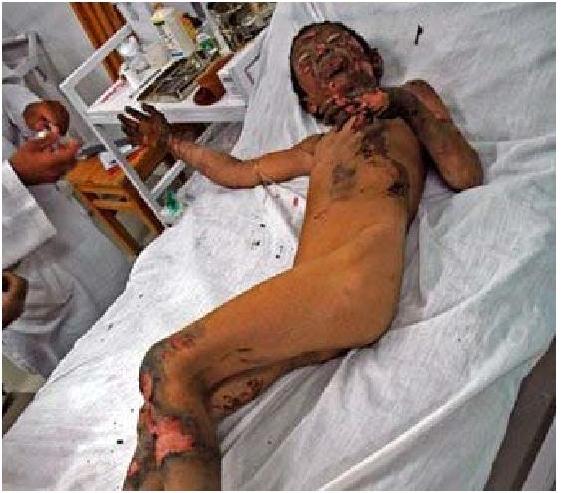
Burned victims of a US bombing in the Kajaki region arrived in October 2006 at the Emergency Hospital in Lashkar Gah. Maso Notarianni took photos of them (Source: http://www.rawa.org/temp/runews/2006/10/31/afghanistan-presumed-taliban.phtml)
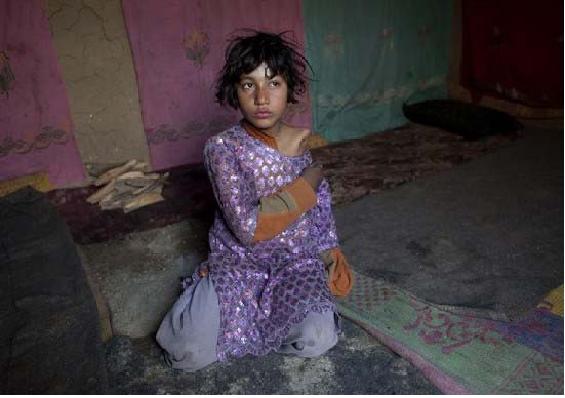
Gul Juma, 10, a girl who lost her arm during a US attack on her village of Sangin, Helmand in December 2008 sits in a mud hut inside a crowded refugee camp of people displaced by the violence, February 10, 2009 in Kabul, Afghanistan (Photo by Paula Bronstein, Getty Images). Details in my Afghan Victim Memorial Project at
http://pubpages.unh.edu/~mwherold/ob_Guljuma10lostherarm_.html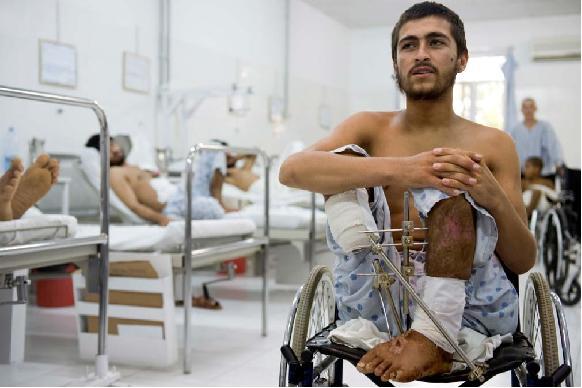
Photo of U.S/NATO bombing victims in the Italian Emergency Hospital in Lashkar Gah, July 2009. Photo by Naoki Tomasini provided to me.
The truth is that Afghanistan is largely irrelevant to U.S designs. For U.S. officialdom,
Afghanistan is seen as an "empty space" as I have argued many times, most recently in my book. [21] The U.S. seeks to re-establish Afghanistan as an empty buffer state at minimum cost (by which I mean few soldiers' bodies and a few dollars). Interestingly, a central component of Al Qaeda's strategy is to bleed America to bankruptcy and to spread out U.S. forces to the greatest degree possible [22] (both captured in the phrase "imperial overstretch"). All the talk about democracy and girls' schools is for public consumption in Euro-America. Indeed, the new so-called humanitarian interventions are merely a smokescreen to hide and sell larger geopolitical agendas. [23]
Al Qaeda is eminently succeeding in piggy-backing upon the Taliban resistance and turning the U.S-led war in Afghanistan into a major financial burden at the time when the Obama administration faces unprecedented deficits. The U.S war in Afghanistan is currently costing $ 5 billion a month, or $115, 740 a minute! [24]
A steady chorus has been maintained by the humanitarian imperialists - enamored with nation-building - who use human rights to sell war. [25] Charter members of this group include Human Rights Watch, Sarah Chayes, the Carr Center at Harvard, Samantha Powers, Code Pink, and many of the guests on National Public Radio. They dream of an idyllic end-game where jolly Afghan farmers labor in cooperatives producing the likes of pomegranates or saffron for export in an Afghan countryside dotted with girls' schools. For such a vision to be established would require the occupation of the countryside. That would involve half a million reliable (presumably NATO) troops - the Vietnamese were far better-trained and much more numerous in 1974-75 and could not prevail. [26] In the interim, the Taliban & Co. sow sufficient violence in order to keep large areas of rural Afghanistan - estimated now at around 80% of the countryside - off-limits to reconstruction. The U.S. policy of setting up Provincial Reconstruction Teams which blend military and civic activities has served to make all reconstruction appear part of counter-insurgency. Such reconstruction efforts thus became targets. You will recall that Medecins Sans Frontieres left Afghanistan in 2004 for that reason despite having been present during the 1990's and the Taliban years. We can thank America for having blurred the boundary between military operations and pure humanitarian efforts to aid the long-suffering Afghan people.
I close with three interrelated points: the American-led war has failed; the only option is to exit as soon as possible; but, sadly, if history provides a lesson such a U.S. exit will not take place until the level of U.S casualties reaches a magnitude which spurs a level of popular opposition to the war that the Obama administration will be forced to act.
Maybe the simplest way to document the utter failure of the American-led war is simply to look at the map of Afghanistan released September 10, 2009 by the British-based International Council on Security and Development (ICOS): Substantial Taliban activity exists in 97 percent of Afghanistan. Areas with heavy Taliban presence rose from 54% in 2007 to 72% in 2008 and to 80% in 2009:
Slide # 12: Taliban Presence Map: January-September 2009
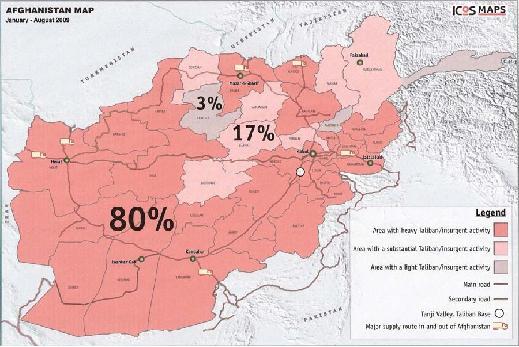
Source: http://www.icosgroup.net/modules/press_releases/eight_years_after_911/print
The U.S military policies of bombing Afghanistan and Pakistan have strengthened not weakened the Taliban and Al Qaeda. As the foreign occupation has worn on, simple Afghan nationalism has soared which, combined with Afghans' practice of revenging a family or friend's death, has fuelled the Afghan resistance. William Polk, a participant in U.S. foreign relations since the Kennedy Administration, put it spot-on,
US military intervention in Afghanistan has not only solidified the Taliban as an organization but has also created increasing public support for it. There is much evidence in Afghanistan, as there has been in every insurgency I have studied, that foreign soldiers increase rather than calm hostility. The British found that to be true even in the American Revolution (where the two sides were "cousins," shared the same religion and spoke the same language). [27]
The very presence now of foreign occupation troops in Afghanistan fuels the resistance. Many Afghans see us as they regarded the Russians, as foreign, anti-Muslim invaders. Again, Polk argues
Even in the tactical short run, I believe, trying to defeat the Taliban is not in America's interest. The harder we try, the more likely terrorism will be to increase and spread. As the history of every insurgency demonstrates, the more foreign boots there are on the ground and the harder the foreigners fight, the more hatred they engender. Substituting drone attacks for ground combat is no solution. Having been bombed from the air, I can attest that it is more infuriating than a ground attack. [28]
The obliteration of Al Qaeda camps has merely served to decentralize that organization across two large continents - Asia and Africa. Thanks to America, Al Qaeda is now a global organization, serving as a force multiplier to local radical Islamic groups. [29]
The only solution is for the U.S. to withdraw as soon as possible just as the Soviets did in early 1989. Even conservative columnist George Will agrees. [30] Certain myths have been cultivated to counter calls for immediate withdrawal.
The first myth asserts that a Taliban presence would lead to a renewed sanctuary for Al Qaeda and again the United States would be vulnerable to a 9/11-style attack. Melvin Goodman at Johns Hopkins has refuted such nonsense,
There are very few al-Qaeda forces in Afghanistan, and both the Bush and Obama administrations have been successful in using Predator strikes against the al-Qaeda leadership in Pakistan, Somalia and Yemen. In the past year, US and Pakistani intelligence have enabled the Predator and other means to eliminate a significant number of al-Qaeda leaders, restrict al-Qaeda's ability to operate and to eliminate some of its financial support. More importantly, al-Qaeda's leadership does not need a sanctuary or safe haven in Afghanistan to plan its operations. The training and preparations for the 9/11 attacks in Washington, DC, and New York City, after all, took place in US flight schools as well as in several apartments in German cities. Paul Pillar, the former deputy chief of the CIA's counterterrorist center has argued that al-Qaeda's terrorist threat is "less one of commander than of ideological lodestar, and for that role a haven is almost meaningless." [31]
A second myth involves the much-ballyhooed fantasy that with judicious carrots-and-sticks the Taliban can be split and weakened. Again, Goodman provides a cogent refutation,
Gen. Stanley A. McChrystal, who commands more than 100,000 US and international forces, has endorsed a counterinsurgency strategy that views the Taliban as a collection of armed groups with different political and economic objectives. McChrystal believes that an additional 40,000 US troops would make it easier to divide the Taliban and wean a significant number of Taliban fighters away from the insurgency. In fact, it is the international coalition that lacks clear direction, and it is Taliban forces that currently have the strategic initiative. The Taliban have demonstrated an increasingly coordinated and centralized approach in their tactics and operations over the past several years, and there is ample evidence that the Afghan population recognizes this fact and has provided greater support to the insurgency. Conversely, the US offensive in Helmand this summer, which involved nearly 20,000 troops, failed to weaken the Taliban on the southern front; the British offensive there three years ago also failed. Secretary of Defense Robert Gates' belief that a significant number of Taliban forces can be brought to our side is dead wrong, and this is the kind of wishful thinking that appears to be central to McChrystal's counterinsurgency strategy. The Taliban may not be monolithic, but they have political control of their forces. Increasing US forces will likely strengthen the Taliban and enhance Taliban recruitment efforts.
Recently, McChrystal proposed outright paying Taliban fighters to defect, a proposal which drew a sharp rebuke from Gilles Dorronsoro of the Carnegie Institute,
You cannot break an insurgency that strong with money. It's not a mercenary force - it's a very powerful movement. [32]
A third myth is to present the Taliban and Al Qaeda as one-and-the-same. This is false as the Taliban have a domestic agenda with no international aspirations whereas Al Qaeda and similar groups are engaged in a global jihad. Moreover, the Taliban learned in late 2001 what the wrath of the United States can accomplish and would not host Al Qaeda again, a point admitted by the few more thoughtful western commentators. [33]
A fourth myth is that the U.S. should stay-the-course and redouble efforts to train Afghan army and police units, akin to the Vietnamization the U.S Indochinese war. [34] Vietnam had a much more developed institutional capacity and a far better motivated army, but in the end little mattered. The Afghan army and police are notoriously unreliable and ineffective as recently argued by Ann Jones. [35]
The Biden approach of relying mostly upon drone strikes targeting alleged Al Qaeda targets in the border areas would further inflame the Pashtuns living in these areas. The Pashtuns and radical Islamists are helpless against the drones and hence revenge would have to be taken out elsewhere, such as in India (Mumbai), Europe (Madrid, London) or the United States. The asymmetric drone warfare would elicit a repeat of 9/11.
Conclusion
But, in my view, none of the reasoning above will encourage the Obama-led occupation of and war in Afghanistan to end. The only thing which will, history has clearly shown us, is when the number of U.S casualties (dead and injured) reaches very high levels as occurred in Indochina after the Tet offensive of 1968, in Beirut in 1983, and in Somalia in 1993. This brings me right back to my beginning point: some bodies matter much more than others in the United States. Regardless of their bodies, when the numbers of ours mount, a U.S war ends.
Notes
1. From Mike Williams, "Bomb Damage at Tora Bora Shows Ferocity of U.S Response," Cox News (December 12, 2001), cited in my "Above the Law and Below Morality: Data on 11 Weeks of U.S. Cluster-Bombing of Afghanistan," Cursor.org (February 1, 2002) at http://cursor.org/stories/abovethelaw.htm
2. In his "Times to Watch the Watchers," The Nation [September 26, 1994]: 304.
3. Sibel Edmonds, "Bombing Afghanistan: Where Have All the Photos Gone?" 123 Real Change (October 4, 2009) at
http://123realchange.blogspot.com/2009/10/bombing-afghanistan-where-have-all.html
4. Mike Davis, "The Poor Man's Air Force," Harper's Magazine (October 2006): 15-20 and a discussion at
http://www.tamilnation.org/forum/cholan/060927poor_mans_airforce.htm
5. Further details in Yusuf Progler, "Racist and Degrading Graffiti in America's Military Culture,"Muslimedia.com at
http://www.muslimedia.com/archives/special99/graffiti.htm
6. This theme is explored and documented at length in my "Matrix of Death: A New Dossier on the (Im)Precision of U.S. Bombing and the (Under)Valuation of Afghan Lives," Frontline. India's National Magazine 25, 21 (October 11-24, 2008) at
http://www.thehindu.com/fline/fl2521/stories/20081024252100400.htm
7. See Michael S. James, "Demonizing the Enemy a Hallmark of War," ABC News (January 29, 2003) at http://abcnews.go.com/print?id=79071
8. Snake and nape refers to in the typical Vietnam close air support load of "snake and nape" (250-lb. Mk-81 Snakeye bombs and 500-lb. M-47 napalm or "nape" canisters).
9. Progler, op. cit.
10. Mir Hekmatullah Sadat, "The Great Game of the 21st Century: 'Civil Liberties, Social Justice & Nation-Building'," Lemar-Aftaab (January-December 2001) at http://www.afghanmagazine.com/2001/commentary/sadat.html
11. Rep. Ron Paul, "Instead of Bombs and Bribes, Let's Try Empathy and Trade," Antiwar.com (October 5, 2009) at
http://original.antiwar.com/paul/2009/10/05/instead-of-bombs-and-bribes/
12. An alleged American exceptionalism would be transferred to foreign policy. This question is explored in Joseph Lepgold and Timothy McKeon, "Is American Foreign Policy Exceptional? An Empirical Analysis," Political Science Quarterly 110, 3 (Autumn 1995): 369-384
13. See the outstanding article by Paul Recher, "USA, Narcissism & Follies aux Beaucoup," The Free Press.org (May 13, 2004) at
http://freepress.org/departments/display/9/2004/656
14. Data from World War II and Vietnam from James P. Harrison, "History's Heaviest Bombing," in Jayne S. Werner and Luu Doan Huynh (eds), The Vietnam War. Vietnamese and American Perspectives (New York: M.E. Sharpe, 1993): 133 and for Cambodia and Afghanistan from Marc W. Herold, "Afghanistan War Produces High Civilians-Killed-Per-Bomb-Ratio," Cursor.org (January 6, 2002) at http://www.cursor.org/stories/civpertons.htm
15. I have examined such in my "Urban Dimensions of the Punishment of Afghanistan by US Bombs," in Stephen Graham (ed), Cities, War, and Terrorism. Towards an Urban Geopolitics (Oxford: Blackwell Publishing, 2003): 312-329
16. See for instance my "Obama's Afghan War. The New Metric of Civilian Casualties," Global Research (June 12, 2009) at http://www.globalresearch.ca/index.php?context=va&aid=13957
17. John Pilger, "Obama, the prince of bait-and-switch," New Statesman (July 24, 2008) at http://www.newstatesman.com/media/2008/07/pilger-obama-afghanistan-news
18. See my "Dead Afghan Civilians: Disrobing the Non-Counters," Cursor.org (August 20, 2002) at http://cursor.org/stories/noncounters.htm; "Truth About Afghan Civilian Casualties Comes Only Through American Lenses for the U.S. Corporate Media [Our Modern-Day Didymus]," in Peter Phillips & Project Censored (eds), Censored 2003. The Top 25 Censored Stories (New York: Seven Stories Press, 2002): 265-294; "Was as an Edsel': the Marketing and Consumption of Modern American Wars," at http://pubpages.unh.edu/~mwherold/ (April 9, 2005); and "The AP Speaks Newspeak. Reporting on Afghanistan and the 1,000 Civilians Killed in 2007 Parrots the Pentagon," Cursor.org (December 12, 2007) at http://cursor.org/stories/apnewspeak.html
19. This massacre is examined in my "How Many Dead Non-White Civilians Does It Take for the U.S. to Notice? Putting the Kunduz Massacre in Context," RAWA News (September 9, 2009) at http://www.rawa.org/temp/runews/2009/09/09/how-many-dead-non-white-civilians-does-it-take-for-the-u-s-to-noticeo-putting-the-kunduz-massacre-in-context.html
20. I have explored this question in "Uncomfortable Others: Afghan Civilians Wounded by America," RAWA News (February 20, 2009) at http://www.rawa.org/temp/runews/2009/02/20/uncomfortable-others-afghan-civilians-wounded-by-america.phtml
21. See my 'Afghanistan Como un Espacio Vacio. El Perfecto Estado Colonial del Siglo XXI' (Madrid: Foca ediciones y distribuciones generales S.L., 2007), pages 312. Earlier drafts of the chapters were published in a series of essays at www.cursor.org beginning with 'Afghanistan as an Empty Space. The Perfect Neo-Colonial State of the 21st Century. Part One', www.cursor.org (February 26, 2006) at http://www.cursor.org/stories/emptyspace.html
22. These points are made in Michael Scheuer, 'Why Doesn't Al Qaeda Attack the U.S.?'Antiwar.com (May 29, 2008) at http://www.antiwar.com/index2345.html
23. From my "An 'Empty' Buffer. For the U.S., Afghanistan is a socio-economically irrelevant space to be kept 'empty' through least-cost military means," Frontline. India's National Magazine 25, 13 (June 21 - July 4, 2008) at http://www.thehindu.com/fline/fl2513/stories/20080704251306200.htm
24. Data from Jo Comerford, "$1 Trillion for War: What Could It Have Gotten?" at http://accuracy.org/newsrelease.php?articleId=2091
25. A classic statement on the topic of humanitarian imperialism remains Jean Bricmont, Humanitarian Imperialism: Using Human Rights to Sell War (New York: Monthly Review Press, 2006), 192 pp.
26. Steve Weissman, "500,000 Troops for Pashtunistan?" Truthout.org (October 6, 2009) at http://truthout.org/1006091
27. William R. Polk, "An Open Letter to President Obama," The Nation (September 30, 2009) at http://www.thenation.com/doc/20091019/polk
28. Polk, op. cit.
29. "Pro-Al-Qaeda London Daily on Anniversary of 9/11: "Al-Qaeda's Continued Existence Proves - War on Terror Has Failed," The Middle East Media Research Institute Special Dispatch No. 2574 (October 1, 2009) at http://memri.org/bin/latestnews.cgi?ID=SD257409
30. George Will, "Time to Get Out of Afghanistan," Washington Post (September 1, 2009) at
http://www.washingtonpost.com/wp-dyn/content/article/2009/08/31/AR2009083102912.html
31. in his "Five Myths on Afghanistan," Trithout.org (October 9, 2009) at http://www.truthout.org/10080910?print
32. Christina Lamb, "Barack Obama Ready to Pay Afghan Fighters to Ditch the Taliban," Times (October 11, 2009) at
http://www.timesonline.co.uk/tol/news/world/Afghanistan/article6869503.ece
33. Like the Britisher, Richard Barrett cited in Scott Shane, "A Dogged Taliban Chief Rebounds, Vexing U.S.," New York Times (October 11, 2009) at http://www.nytimes.com/2009/10/11/world/asia/11mullah.html?_r=1&partner=rss&emc=rss
34. by the president of the U.S Council on Foreign Relations, Richard N. Haas, "In the Afghan War, Aim for the Middle," Washington Post (October 10, 2009) at http://www.washingtonpost.com/wp-dyn/content/article/2009/10/09/AR2009100902576.html
35. Ann Jones, "There's Virtually Zero Percent Chance of There Ever Being a Real Afghan Army - So What's the Pentagon Talking About?" http://www.alternet.org/module/printversion/142775



















Sem comentários:
Enviar um comentário